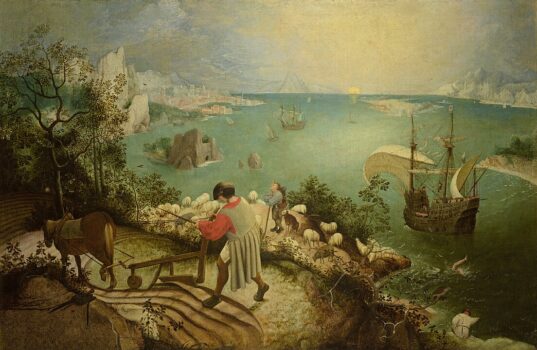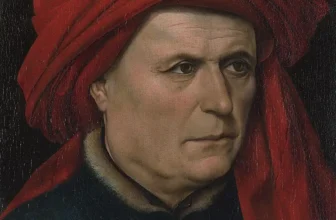Unpacking Bruegel’s Landscape with the Fall of Icarus
What Is Landscape with the Fall of Icarus All About
At first glance, Landscape with the Fall of Icarus might seem like a tranquil pastoral scene, perhaps even mundane in its depiction of daily labor. A farmer plows his field, a shepherd tends his flock, and a fisherman leans over the water. But look closer, and you’ll see something peculiar, almost hidden in the corner: the legs of a man, flailing helplessly in the sea. That man is Icarus, the tragic figure from Greek mythology who dared to fly too close to the sun. The genius of this painting lies not in what it overtly shows, but in what it chooses to minimize.
Painted by Pieter Bruegel the Elder around 1558, Landscape with the Fall of Icarus is one of the most enigmatic and thought-provoking artworks of the Northern Renaissance. Unlike typical mythological paintings that glorify the hero’s journey, Bruegel’s work deliberately downplays the mythological spectacle. Instead, it highlights the indifference of the world to personal tragedy. This painting is not just a retelling of a Greek myth, it is a profound commentary on human nature, society, and the often-overlooked consequences of hubris and ambition.
At its core, Landscape with the Fall of Icarus is about the unnoticed tragedy in the midst of everyday life. It portrays a moment from Ovid’s Metamorphoses, where Icarus, having flown too close to the sun with wings made of feathers and wax, falls into the sea and drowns. But Bruegel does something radical with this well-known story: he relegates the mythological event to the background, almost literally.
Instead of focusing on Icarus and his dramatic fall, Bruegel shifts the viewer’s attention to ordinary people engaged in their daily routines. The painting becomes a meditation on human indifference, where life goes on uninterrupted, even as someone perishes just out of sight. It questions our tendency to overlook suffering that does not directly affect us. In doing so, the work transcends its mythological subject and enters the realm of social and philosophical commentary.
What Is Happening in the Painting?
The composition of Landscape with the Fall of Icarus is deceptively simple. The foreground is dominated by a plowman guiding his horse across a sunlit field. A shepherd stands with his sheep, pointing skyward, possibly indicating Daedalus still flying. A fisherman sits near the edge of the sea, absorbed in his task. The sea itself is calm, almost serene, and a large ship sails toward the horizon.
Only upon close inspection does the viewer notice Icarus, partially submerged, his legs the only visible sign of his existence. There is no dramatic splash, no crowd gathering, no mournful cry, just a pair of legs disappearing into the water.
The irony is stark. The fall of Icarus, a moment that should have been cataclysmic, barely registers in the landscape. The sun, the very thing that caused his demise, still shines brightly above, indifferent and unyielding.
Symbolism in Landscape with the Fall of Icarus
Bruegel’s painting is rich with symbolism, offering a visual allegory that rewards deeper contemplation.
1. The Fall of Icarus as a Warning Against Hubris
The Greek myth of Icarus is itself a cautionary tale. Icarus’s father, Daedalus, constructed wings for them both to escape Crete, warning his son not to fly too close to the sun or too close to the sea. Icarus, exhilarated by the thrill of flight, ignored the warning. The wax on his wings melted, and he plunged into the sea.
By minimizing Icarus’s presence in the painting, Bruegel seems to emphasize the insignificance of individual hubris in the broader tapestry of life. While Icarus’s story is about the consequences of overreaching, Bruegel adds a layer of existential reflection: no matter how grand our ambitions or dramatic our failures, the world rarely stops to take notice.
2. The Plowman, Shepherd, and Fisherman
These three figures are often interpreted as symbols of the three traditional “estates” or classes in medieval society: the laborers (the plowman), the pastoral caretakers (the shepherd), and those who live by the sea (the fisherman). Each one is immersed in their own task, oblivious to the mythological tragedy unfolding nearby.
Their presence might also represent the continuity of life and the apathy of mankind toward the suffering of others. The plowman continues his work, a symbol of the enduring nature of toil. The shepherd, though looking up, does not act. The fisherman remains transfixed by his catch. This trio, unconcerned with the death of Icarus, highlights the world’s persistent inertia in the face of individual loss.
3. The Sea
The sea into which Icarus falls is vast, indifferent, and serene. In literature and art, the sea often symbolizes the unconscious, the unknown, or the infinite. Here, it becomes a symbol of oblivion. Icarus disappears into the sea as though into the void, swallowed up by the larger world that continues unchanged.
4. The Ship
The large ship in the distance may symbolize commerce or society’s broader journey. Despite being near the site of Icarus’s fall, the ship sails on without deviation. It underscores the idea that society moves forward, unaware or indifferent to personal catastrophe.
5. The Sun
The sun hangs high above, shining brightly, almost cruelly, in its role in Icarus’s demise. While it is the direct cause of Icarus’s fall, melting his wings, it is also the symbol of knowledge, enlightenment, and power. This duality makes the sun both a source of life and destruction, reflecting the double-edged nature of human ambition.
Interpretation: What Does It All Mean?
Bruegel’s Landscape with the Fall of Icarus invites multiple interpretations, many of which are shaped by the context of 16th-century Europe as well as timeless philosophical questions.
1. A Critique of Human Indifference
The most common interpretation is that Bruegel is commenting on human apathy. In the face of tragedy, no matter how dramatic or avoidable, life carries on. The people in the painting do not notice Icarus, just as we often fail to notice the suffering of others around us. This is an especially poignant message in an era of war, famine, and religious upheaval.
2. The Tragedy of Isolation
There’s also a sense of isolation in ambition. Icarus’s journey is solitary, as is his demise. No one was there to share in his triumph or mourn his fall. In this interpretation, the painting reflects on how ambition and the pursuit of greatness can separate individuals from the collective, making their failures private and unnoticed.
3. Satirical View of Heroism
Bruegel may also be satirizing the grandiose notions of heroism and myth. By minimizing Icarus, he reduces the mythological event to a footnote in the broader story of human existence. This could be seen as an early form of anti-heroic realism, where the focus shifts from gods and heroes to ordinary people and their enduring struggles.
4. Mortality and the Mundane
Another interpretation centers on mortality. Icarus, despite his attempt to transcend earthly limits, meets a mundane end, drowned and unnoticed. Bruegel’s message might be that death comes quietly, often without drama, and the world continues as though nothing has changed. This reflects a deeply humanist perspective rooted in the Renaissance.
Artistic Style and Type
Northern Renaissance Realism
Landscape with the Fall of Icarus is typically categorized as a Northern Renaissance painting, though its attribution to Pieter Bruegel the Elder has been debated. (More on that below.) Stylistically, the work reflects Northern European realism, with its focus on naturalistic detail, landscape, and the lives of ordinary people.
Unlike Italian Renaissance artists who glorified the human form and classical mythology, Northern Renaissance painters like Bruegel focused on the grit and beauty of everyday life. Their works often contain moral or satirical undertones, and Landscape with the Fall of Icarus is no exception.
Oil on Canvas
The painting is done in oil on canvas, a medium that allowed for rich detail and subtle transitions in light and color. The use of perspective and scale in the painting directs the viewer’s attention toward the foreground, reinforcing the idea that the mythological event is secondary to the life of ordinary people.
Where Is the Landscape with the Fall of Icarus Painting Today?
The original Landscape with the Fall of Icarus is housed at the Royal Museums of Fine Arts of Belgium in Brussels. However, there has been considerable scholarly debate over whether Bruegel the Elder actually painted it. Some art historians argue that it may be a later copy based on Bruegel’s original composition, possibly created by an unknown artist in the 16th century after Bruegel’s death.
Despite the questions surrounding its attribution, the painting remains one of the most discussed and admired works associated with Bruegel. Its power lies not just in its technique, but in the boldness of its vision and the subtlety of its message.
Landscape with the Fall of Icarus is more than just a reinterpretation of a Greek myth, it is a profound meditation on the human condition. Through its quiet composition and subdued tragedy, it confronts viewers with uncomfortable truths about indifference, ambition, and mortality.
Bruegel’s genius lies in how he upends narrative expectations. In a world that often celebrates the spectacular and the heroic, he turns the spotlight away from Icarus and onto the unnoticed, the mundane, the real. He compels us to ask: Who sees when we fall? And if no one does, what then is the meaning of our striving?
In a sense, Landscape with the Fall of Icarus becomes not just a painting, but a mirror, reflecting our own society’s distractions, preoccupations, and emotional distance. It reminds us that while tragedy may go unnoticed, its impact is no less real, and that perhaps, in noticing, we can begin to reclaim our shared humanity.




